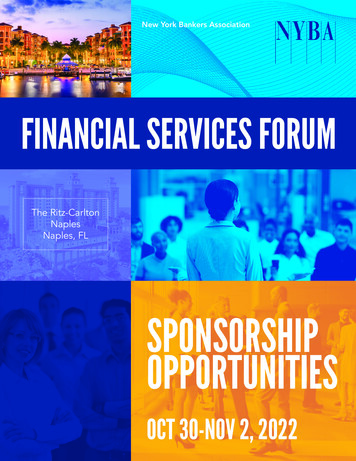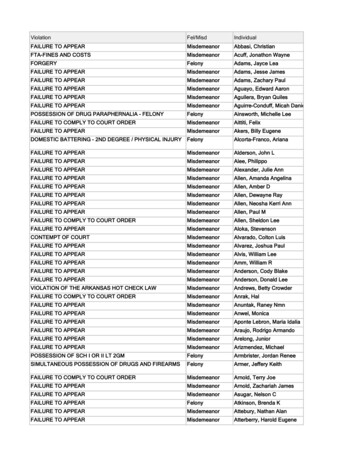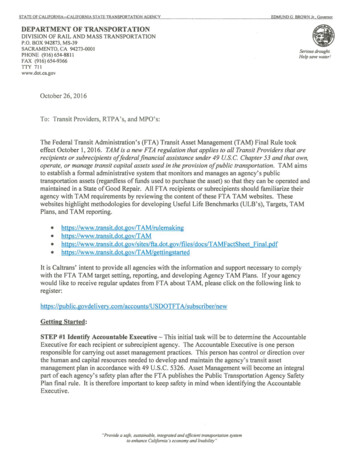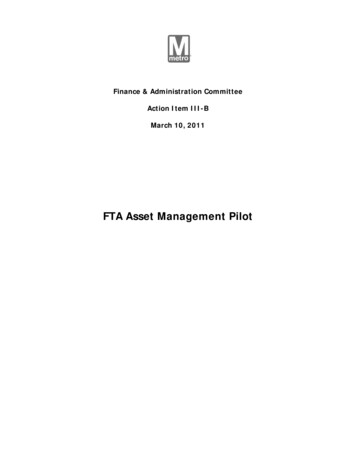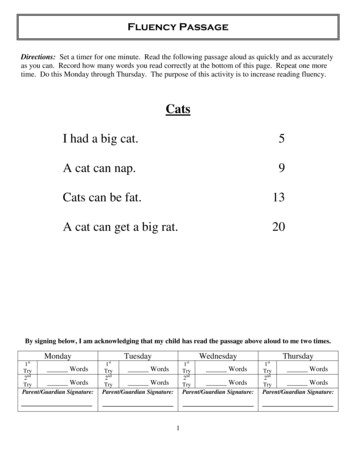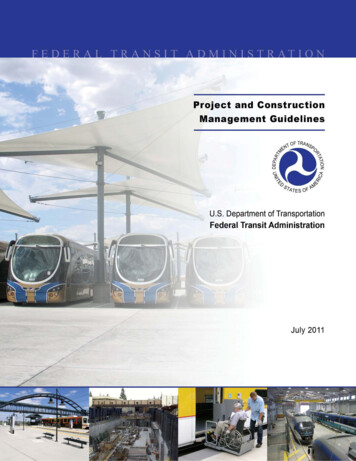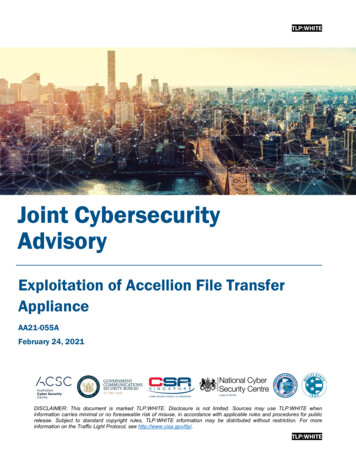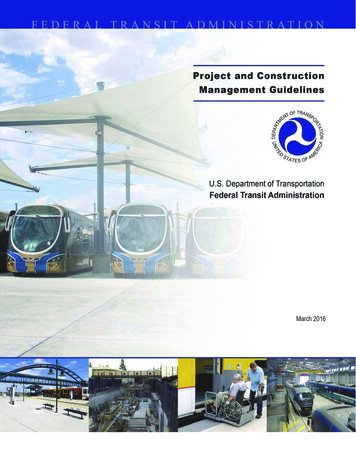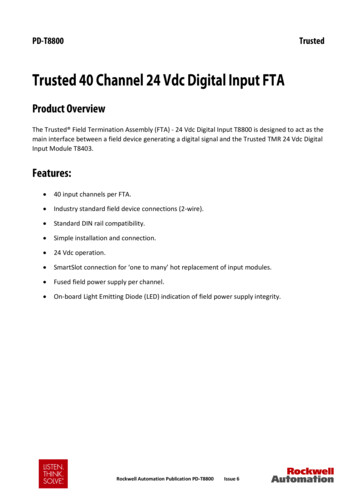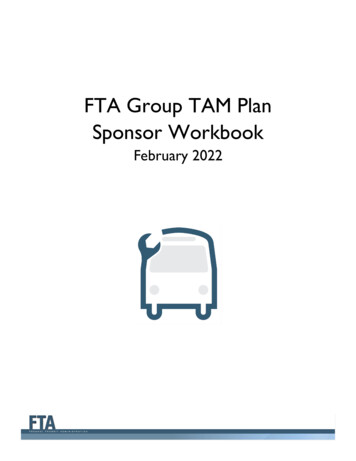
Transcription
FTA Group TAM PlanSponsor WorkbookFebruary 2022
Table of ContentsTable of Contents . 2I.Introduction . 3Purpose . 3Audience . 3II. How to Use this Document . 3III. Background . 4IV. Applicability . 4Sponsoring the Group Plan . 4Identifying Participants . 5Timeline . 6V. Expectations of Sponsors. 7Defining Group. 8Defining Roles . 8Communication . 9VI. Developing a Group Plan . 9Creating an Asset Inventory .11Conducting Condition Assessments .12Using Decision Support Tools .14Prioritizing Investments .16Approving the Plan .17Reporting to the National Transit Database .17Sharing Group TAM Plans .19VII. Other Considerations.20Amending and Updating Group TAM Plan .20No Participants in Group TAM Plan .20Creating Multiple Group TAM Plans .20Adjusting Group Plan Participants .21Oversight.22Funding for TAM Activities .23VIII. Resources.24Appendix A: Group TAM Plan Timeline .25Appendix B: TAM Final Rule Definitions .26FTA Group TAM Plan Sponsor Workbook2
I.IntroductionPurposeThis document provides a consolidated list of activities, considerations, suggestions, and best practicesrelated to group Transit Asset Management (TAM) plans to assist Group Plan sponsors in developing aGroup Plan. Please note that this document is not official guidance.AudienceThe primary intended audience for this document is group TAM plan sponsors, whether required orvoluntary. Tier II subrecipients, whether or not they choose to participate in a Group Plan, may also findthis document useful for understanding Group Plans.II. How to Use this DocumentThe document is organized by the steps used to createa compliant group TAM plan: Section III: Background: This section provides abrief overview of the TAM Final Rule and theconcept of a Group Plan.Section IV: Applicability: This section helpsreaders to understand if they are required todevelop a Group Plan and to identify theirparticipants.Section V: Expectations of Sponsors: This sectionhelps identify who is involved in each elementof the Group Plan and offers suggestions onhow to make these decisions.Section VI: Developing a Group Plan: Thissection deals directly with the elements of aTAM plan and the coordination and reportingresponsibilities.Section VII: Other Considerations: This sectionhighlights unique or less frequent scenarios thatsponsors may encounter when developingGroup Plans, including funding and oversightconsiderations.Section VIII: Resources: This section includes alist of resources that can be useful indeveloping a Group Plan.A Description of the Four RequiredElements of Group TAM PlansAsset Inventory: A register, repository, orcomprehensive list of an agency’s assetsand specific information about thoseassets.Condition Assessment: The process ofassessing and documenting the conditionor residual life of an asset.Decision Support Tools: An analyticprocess or methodology to: (1) helpprioritize projects to improve andmaintain the state of good repair ofcapital assets within a publictransportation system, based onavailable condition data and objectivecriteria; or, (2) assess financial needs forasset investments over time.Investment Prioritization: A transitprovider’s ranking of capital projects orprograms to achieve or maintain a stateof good repair based on financialresources from all sources that a transitprovider reasonably anticipates will beavailable over the TAM plan horizonperiod.FTA Group TAM Plan Sponsor Workbook3
III. BackgroundThe purpose of the Group Plan option is to reduce the planning and reporting burden on smaller transitagencies from having to develop individual plans and to report to FTA’s National Transit Database (NTD)on their own.The National Transit Asset Management System Final Rule (49 U.S.C. 625) requires that all agencies thatreceive federal financial assistance under 49 U.S.C. Chapter 53 and own, operate, or manage capitalassets used in the provision of public transportation create a TAM plan. Agencies are required to fulfillthis requirement through an individual or Group Plan. Group Plans are designed to collect TAMinformation about groups (typicallyTier IITier Ismaller subrecipients of 5311 or 5310grant programs) that do not have aSubrecipient of 5311 fundsOperates railORORdirect financial relationship with FTA. 101 vehicles across allfixed route modesOR 101 vehicles in one nonfixed route modeAmerican Indian TribeOR 100 vehicles across all fixedroute modesOR 100 vehicles in one non-fixedroute modeTier I and Tier II providers havedifferent requirements whendeveloping a TAM plan. To identify TierI and Tier II providers, refer to Figure 1.Note that if an agency exclusivelyreceives rural program formula funds(section 5311), it is a Tier II agency.Figure 1: Defining Tier I and Tier II ProvidersEach Tier I agency (typically largerfleets and/or those that provide railservice) is required to develop an individual TAM plan with all nine elements,1 while Group Plans andindividual Tier II plans require just four elements. For regulation language and information on whetheryour agency is a Tier I or Tier II provider, see the FTA checklist Am I a Tier I or Tier II Agency? For moreinformation on general TAM plan requirements, see FTA’s TAM Plan web page and Final Rule Fact Sheet.For a list of TAM-related terms and their definitions per the Final Rule, see Appendix B.IV. ApplicabilityTypical Sponsor AgenciesSponsoring the Group PlanGroup Plan sponsors include direct or designatedrecipients of section 5311, 5307, and 5310 funds with atleast one subrecipient that is a provider of publictransportation. State Departments of Transportation(State DOTs) are the most common sponsors, butMetropolitan Planning Organizations (MPOs) or transitagencies can also sponsor Group Plans. To determine State DOT MPO Tier I agency Tier II direct recipient American Indian Tribe Other (e.g. designated recipients)1Tier I agencies are also required to include the elements: TAM & SGR Policy, Implementation Strategy, Key List ofAnnual Activities, Identification of Resources, and Evaluation Plan.FTA Group TAM Plan Sponsor Workbook4
whether your agency is required to be a sponsor, use the FTA checklist Am I required to be a Group TAMPlan Sponsor?Identifying ParticipantsSponsors must guarantee the option to participate in a Group Plan to applicable Tier II transit agenciesthat do not also receive 5307 funds. Sponsors should proactively reach out to these subrecipients todetermine whether they plan to participate in the sponsor’s Group Plan. If the subrecipient does notplan to participate, they must “opt-out” in writing and notify the sponsor as to how they will meet theirTAM plan requirements, either by participating in a different Group Plan or by completing an individualplan. For additional information, see Section V: “Expectation of Sponsors” for a discussion oncommunication that provides some suggestions of how to ensure appropriate recordkeeping forparticipants and opt-outs of Group Plans.While specific policies may not come into discussion until later in the development of the Group Plan,sponsors and participating agencies should make sure that they agree in terms of TAM philosophy,general policies, and roles prior to commitment to participate. It is not always possible to anticipatedisagreements regarding policies and philosophy but setting expectations and open communication canhelp keep goals and responsibilities clear.The following subsections cover details regarding additional considerations in identifying which types ofagencies a sponsor is or is not required to offer participation in their Group Plan.TribalSponsors are not required to solicit participation of American Indian Tribes that receive funding onlythrough section 5311(c), but if the Tribe requests to participate, the sponsor must accept the Tribe intotheir Group Plan.Since sponsors may not decline participation from American Indian Tribes, sponsors might decide toinclude relevant American Indian Tribes in initial communication outreach and scheduling. While this isnot required, it will inform these potential participants of the opt-out date and may save the sponsorfrom having to redevelop parts of the Group Plan, should the Tribe decide to join later.In some cases, Tribes may decide to join with other tribal groups that have similar interests andexperience to complete a Group Plan. In this case, one of the Tribes would serve as the Group Plansponsor and would report targets for all participants.5307-funded SubrecipientsSponsors are not required to solicit participation of subrecipients that also have a direct fundingrelationship with FTA through section 5307 (Urbanized Area Formula Program).However, sponsors should be aware that they might receive communication from Tier II direct recipientsof section 5307 funds requesting permission to participate. The sponsor can choose to allow suchagencies to join. Section VII, “Other Considerations,” provides considerations for sponsors whendetermining whether to accept a request for participation and when considering inviting additionalgroups into the plan.FTA Group TAM Plan Sponsor Workbook5
5310-funded SubrecipientsExamples of 5310-funded subrecipients (EnhancedMobility of Seniors & Individuals with Disabilities) thatare included in the TAM Rule and require a TAM plan arecouncils on aging and senior center transportationproviders. Section 5310 funding subrecipients that arenot operators of public transportation are not requiredto participate in a TAM plan. For example, church vansthat receive 5310 funding or other client-based servicesare not subject to the TAM Rule.Public Transportation Providers(49 USC 5302)Public transportation refers to regular,continuing shared-ride surfacetransportation services that are open tothe general public, or are open to asegment of the general public defined byage, disability, or low income.TYOther Rail or Rubber Tire ServicesOther examples of services that are not considered public transportation and therefore do not need tohave a TAM Plan include intercity rail or bus; charter, school, and sightseeing services; courtesy shuttle;and intra-terminal or intra- facility shuttle services, such as airport shuttles. 2Inviting Additional ParticipantsThe Final Rule only requires sponsors to offer participation in their Group Plan to subrecipients.However, they may offer participation to any Tier II operator. Because the Group Plan component of theFinal Rule was established to connect participants and sponsors that have a financial relationship, thesponsor should consider the benefits of other potential financial and strategic relationships wheninviting additional participants to the plan. For example, a State may choose to invite all Tier II agenciesto participate in a single plan to streamline policy discussions and analysis for transit associated with theState Transportation Improvement Plan (STIP).However, for those agencies without a financial relationship with the sponsor, there may be limitedbenefits to including them, and doing so may add additional strain on the budget, staff, and timeline.This is particularly true if the potential participant has different needs and priorities than the sponsorand other Group Plan participants. For additional information, see other considerations of includingadditional participants in a Group Plan under “Defining Roles” in Section V.TimelineCreating a Group Plan requires coordination and preparation to develop the plan, which may take asignificant amount of time depending on plan complexity (e.g. number of subrecipients, data availability,etc.). Figure 2 visualizes the cycle for developing, implementing, and updating the plan. A full timelinereference with descriptions of potential actions in each phase is available in Appendix A: Group TAMPlan Timeline”.2Paraphrased from Public Transportation definition 49 USC 5302(14).FTA Group TAM Plan Sponsor Workbook6
Figure 2: Phasing of TAM Plan Creation and Related ProcessesBelow is a general description of the phases listed in Figure 2.ScopeSponsors determine whether they must offer a Group Plan and to whom. They identify and inviteeligible participants. They also define the roles and responsibilities for themselves and their participants.CollectSponsors and participants work together to collect data to create an asset inventory and conductcondition assessments.CreateSponsors lead the effort to create the group TAM plan document, which includes the four TAM planelements: asset inventory, condition assessment, decision support tools, and investment prioritization.Concur and ShareEach participants’ Accountable Executive approves and signs off on the Group Plan and the sponsorshares the approved Group Plan with stakeholders (i.e. State DOTs and MPOs) and other pertinentorganizations.Implement and ReportThis phase is ongoing since the Group Plan is implemented over a four- year time horizon. Sponsors andparticipants continuously work toward meeting targets, which are set and reported annually to theNational Transit Database. Data collection is also ongoing to maintain an up-to-date asset inventory andcondition assessments.V. Expectations of SponsorsThe overarching role of the sponsor is to coordinate and write the Group Plan. Additionally, the sponsorwill set performance targets for the group’s capital assets and report them, as applicable, to theNational Transit Database (NTD). The sponsor will use decision support tools and analytical processes todevelop investment prioritization for the group.FTA Group TAM Plan Sponsor Workbook7
Defining GroupThe sponsor is responsible for the process of coordinating development of and submitting the GroupPlan. While sponsors are only required to create one Group Plan, depending on the geography,differences in operations, and the number of participants in the group, it could make more sense tocreate multiple plans.Defining RolesAccountable ExecutiveOnce the sponsor identifies and confirms participation inthe Group Plan, the sponsor must consider itsexpectations and relationship with plan participants.Although the Group Plan structure takes a top-downapproach, how and the extent to which the sponsorshares responsibilities with the participants may vary.The exact relationship between the sponsor andparticipant in the Group Plan process is a local decision.Each Group Plan sponsor will coordinate with itsparticipants to identify their specific roles andresponsibilities in the process.Group plan participants may vary in the level of datacurrently available and staff capacity to support a TAMplan. Some may have skills and experience with TAMplanning efforts, software, and tools, while otherparticipants may lack the capacity to fulfill somerequirements without support. The sponsor should beaware that participants will have a variety of skillsets andshould be prepared to work with each participantregardless of their current capacity for TAM planningefforts.Each participant will have an AccountableExecutive responsible for approving thegroup TAM plan. The agency identifiestheir Accountable Executive, which is notrequired to be a new position. In somecases, the Accountable Executive may bethe same individual that certifies the NTDreport.While the Accountable Executive isultimately responsible for the agency’sTAM plan, other staff should be involvedin the day-to-day development andimplementation of the TAM plan. Insome agencies, one staff person may beresponsible for coordinating all aspectsof TAM planning with the Group Plansponsor. In other agencies, staff fromthroughout the organization will providetheir technical expertise. In smallagencies where resources are limited,the Accountable Executive may assumemore of the day-to-day responsibilities.In some cases, it may be appropriate for the sponsor tohave primary responsibility for all aspects of the GroupPlan while in other cases the participants may want toshare responsibility. The sponsor should define the procedures for its participants, including when andwhat kind of information will be collected and the extent to which each agency’s Accountable Executiveand other points of contact will be involved.For example, a State DOT with strong leadership and resources may want to conduct conditionassessments for its participants, whereas a more decentralized State DOT may only collect the assetdata, requiring each participant to conduct the condition assessments individually. Agency capacity,funding availability, existing data streams, and geographical or staffing concerns, among others, couldinfluence the approach taken by a State DOT. Some considerations for determining what approach asponsor may take include desired consistency of data collection, availability of standards and dataFTA Group TAM Plan Sponsor Workbook8
repositories for participants, existing data availability, and how the sponsor intends to use the data oncecollected.CommunicationCommunication between sponsors and participants is critical to Group Plan success. While the exactrelationship between sponsors and participants is a local decision, sponsors should initiate and preparea clear structure of communication for the participants and document this communication structure intheir plan. Sponsors may want to include a way for participants to provide feedback to the sponsor anda plan to handle disagreements. It is recommended that the sponsor communicate to its potentialparticipants a schedule for Group Plan development, which clearly identifies the opt-out date in advanceof the next TAM plan due date. Sponsors should set a timeframe for participants to give notice of optingout, such as 12 months, or whatever the appropriate timeframe established by the sponsor agency tomeet planning and capital deadlines. A long lead-time might be necessary to assure sufficient time forboth the participants and the sponsor to collect and verify data and perform analysis by the requiredTAM plan deadlines. It is important that throughout the process the sponsor initiates, maintains, anddocuments communication with the participants of the Group Plan.While collaboration with participants is an overarching responsibility, it is ultimately up to the sponsorto decide, develop, and communicate: Eligibility for participation in the Group Plan; Plans, timeline, and deadlines for TAM plan development; Data needs and formats from agencies; Procedures for having policy discussions; Plans for setting targets and prioritizing investments; Thresholds for amending the TAM plan; Thresholds for a TAM plan update; Coordination with planning organizations; and, Expectations for the process of opting out.VI. Developing a Group PlanThe Transit Asset Management Guide and Asset Management Guide for Small Providers discuss thecomponents of good asset management practices including the four Group Plan elements, in detail. Thissection discusses considerations of each step chronologically, and focuses on the components of theseelements as they relate specifically to Group Plans. The numbered elements in this section correspondwith TAM plan elements required to be in Group Plans. The roles of sponsors and participants will varybetween each plan and element, and are a local decision. In some cases, participants in the same planmay even have differing levels of responsibility based on each agency’s sophistication and availableresources. The table below offers a general idea of the sponsor and participant efforts for each of thefour required elements of the plan.FTA Group TAM Plan Sponsor Workbook9
Table 1: Example Sponsor and Participant Roles in Group Plan DevelopmentElementSponsor Write plan Coordinate consolidationDevelop/modify database orsoftwareDefine data collection elements andformats Define data collection methodologyand scheduleManage data (i.e.database/software)Submit data to NTD**Share guiding policies includingweighting or ranking prioritiesDevelop toolsAnalyze and interpret dataGather additional dataPrioritize projects (iterative step)Generate ranked list of projects OverarchingAssetInventory ConditionAssessment* DecisionSupport ToolsInvestmentPrioritizationParticipant Annual TargetSettingAnnualNarrativeReport Support/conduct conditionassessmentSubmit data to sponsor in formatrequired on schedule Communicate goals and needsProvide information to supporttool Share info on all funding sourceswith sponsorShare existing Capital InvestmentPlansCoordinate with sponsor Support planAccountable Executive approvesplanCollect asset dataSubmit data in format required onscheduleCoordinate target setting with theparticipating transit providers’Accountable Executives, to theextent practicableReport targets to NTDDevelop the Annual Narrative ReportSubmit narrative to NTDFor those participants that do notreport independently, report basicTAM information including:o Agency profileo Asset inventoryo Facility condition assessment (asapplicable) Those participants that reportindependently to NTD areresponsible for reporting basicNTD AssetTAM information including:Inventoryo Agency profileo Asset inventoryo Facility condition assessment(as applicable)*Asset condition assessments can be completed in a variety of ways and are ultimately local decisionsmade by the Group Plan sponsor.**For agencies not already directly reporting to the NTD (see NTD Asset Inventory row).FTA Group TAM Plan Sponsor Workbook10
Creating an Asset InventoryThe asset inventory defines the assets used by all agencies that are participating in the Group Plan. Theinventory should include all assets the providers own, as well as third party assets used in the provisionof public transportation, broken into three categories: Equipment, Rolling Stock, and Facilities. Table 2:Example Asset Categories and Classesprovides examples of asset classes within each category.Table 2: Example Asset Categories and ClassesAsset CategoryEquipmentRolling StockFacilitiesExample Asset ClassConstructionService VehiclesMaintenanceBusesFerriesOther Passenger VehiclesAdministrative and MaintenancePassenger and ParkingAlthough these categories are used for asset inventory and condition assessment, not all participantswill have assets in every category. In particular, most Tier II agencies will have relatively limited or noinfrastructure assets, and therefore the infrastructure requirements and performance measure will notapply. The asset inventory should be commensurate with the level of detail used in defining the programof capital projects. Group Plan sponsors may determine that additional assets or a more detailedbreakdown of assets should be included in the asset inventory, beyond those defined by FTA.The way assets are identified in the capital plan can affect how assets are reported in the TAM plan. Thisis most relevant for the equipment category given the 50,000 threshold that determines if an asset isrequired to be inventoried. If the participant has a capital line item that has (individually or in a group)equipment assets that value over 50,000, they will need to be listed as a commensurate item in theGroup Plan inventory. For example, if a participant’s capital plan lists its purchase of multiple portablevehicle lifts as one line item over 50,000, then the lifts would be listed as an equipment asset in theinventory in the plan. Alternatively, if each portable vehicle lift is listed as an individual line item under 50,000, they would not be included in the Group Plan inventory.The Group Plan has a combined asset inventory. For example, if a Group Plan has four participants, thecutaway vehicles can be grouped together so that all of the agencies’ cutaway buses purchased in agiven year are listed as one item when considered as part of the Group Plan. However, the Group Plansponsor may want to inventory these vehicles to a more detailed level for their own records, keepinglinks to who owns and operates each vehicle, as well as other characteristics about them such as VIN,mileage, and any major maintenance they have received. While the sponsor may aggregate assets in theGroup Plan, it is necessary to keep them separate for submittal to NTD, which inventories assets byagency fleet. See additional information in Section VI: “Reporting to NTD”.FTA Group TAM Plan Sponsor Workbook11
Sponsors should ensure that participants understand FTA’s reporting requirements for asset inventoriesand condition assessments. Participants will inventory all assets used in provision of publictransportation, but are only required to assess condition on assets for which they have direct capitalresponsibility. See the responses to What assets must I include in a TAM asset inventory? and What isthe difference between assets in my TAM plan and NTD inventory and targets? on the TAM FrequentlyAsked Questions (FAQs) page for a more detailed description of what needs to be included.Shared AssetsWhen multiple transportation agencies share a capital asset, each agency is responsible for including theasset in its asset inventory, but the condition assessment only needs to be completed once. Theagencies must determine collectively which of them will conduct the condition assessment of that assetand then provide the data to the other agencies. Communication between agencies with shared assetsis crucial during the condition assessment phase of the TAM plan, although it may be relativelystraightforward if all the agencies are participating in a single Group Plan. In this case, when assetinventories are aggregated, they may be identified as a singular asset within the Group Plan since it doesnot necessarily link assets to specific participants. However, agencies that share a capital asset mustinclude it in each agency’s NTD asset reporting. If facility is a shared asset, each agency should reportthe same value for the condition assessment. See the response to What must be reported when afacility is shared? on the TAM FAQs page for more information.Data CollectionGroup Plan sponsors should determine what data will be required from participants, and by whatmechanism the data will be collected. Since the Group Plan sponsor likely has some financial andoversight relationship with the participants, it may already be tracking at least a subset of t
individual Tier II plans require just four elements. For regulation language and information on whether your agency is a Tier I or Tier II provider, see the FTA checklist Am I a Tier I or Tier II Agency? For more information on general TAM plan requirements, see FTA's TAM Plan web page and Final Rule Fact Sheet.

